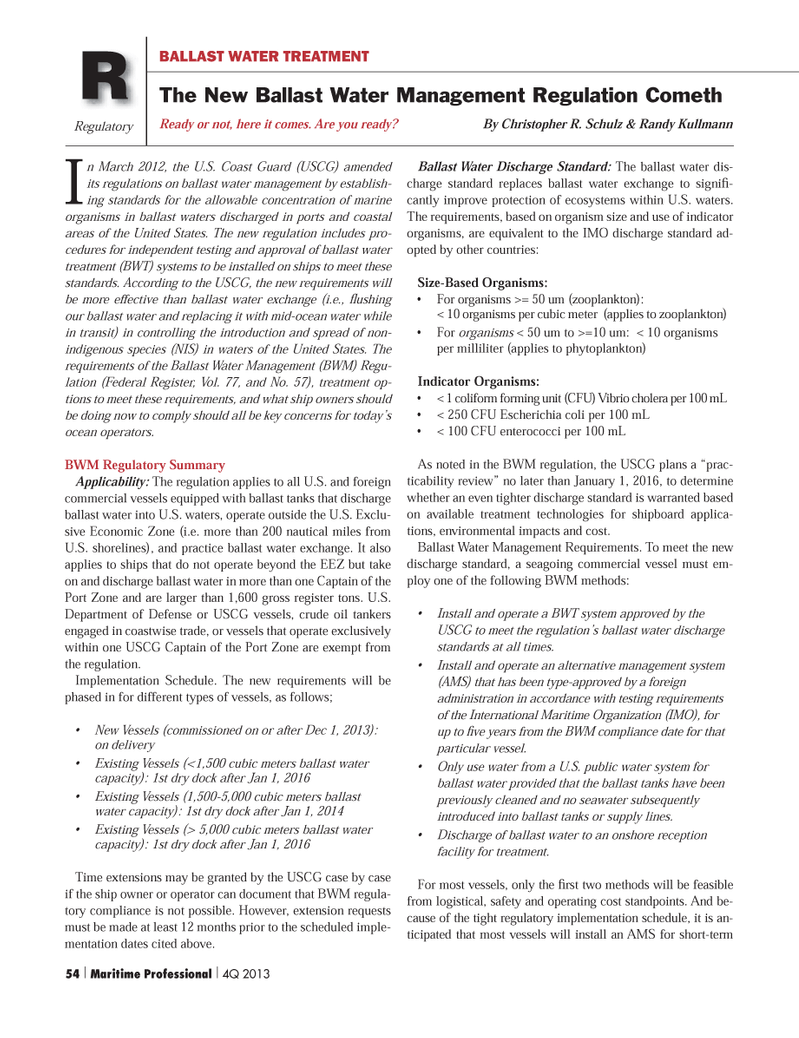
Page 54: of Maritime Logistics Professional Magazine (Q4 2013)
Shipbuilding, Repair
Read this page in Pdf, Flash or Html5 edition of Q4 2013 Maritime Logistics Professional Magazine
In March 2012, the U.S. Coast Guard (USCG) amended its regulations on ballast water management by establish- ing standards for the allowable concentration of marine organisms in ballast waters discharged in ports and coastal areas of the United States. The new regulation includes pro- cedures for independent testing and approval of ballast water treatment (BWT) systems to be installed on ships to meet these standards. According to the USCG, the new requirements will be more effective than ballast water exchange (i.e., ß ushing our ballast water and replacing it with mid-ocean water while in transit) in controlling the introduction and spread of non- indigenous species (NIS) in waters of the United States. The requirements of the Ballast Water Management (BWM) Regu- lation (Federal Register, Vol. 77, and No. 57), treatment op- tions to meet these requirements, and what ship owners should be doing now to comply should all be key concerns for todayÕs ocean operators. BWM Regulatory SummaryApplicability: The regulation applies to all U.S. and foreign commercial vessels equipped with ballast tanks that discharge ballast water into U.S. waters, operate outside the U.S. Exclu- sive Economic Zone (i.e. more than 200 nautical miles from U.S. shorelines), and practice ballast water exchange. It also applies to ships that do not operate beyond the EEZ but take on and discharge ballast water in more than one Captain of the Port Zone and are larger than 1,600 gross register tons. U.S. Department of Defense or USCG vessels, crude oil tankers engaged in coastwise trade, or vessels that operate exclusively within one USCG Captain of the Port Zone are exempt from the regulation. Implementation Schedule. The new requirements will be phased in for different types of vessels, as follows; ¥ New Vessels (commissioned on or after Dec 1, 2013): on delivery ¥ Existing Vessels (<1,500 cubic meters ballast water capacity): 1st dry dock after Jan 1, 2016 ¥ Existing Vessels (1,500-5,000 cubic meters ballast water capacity): 1st dry dock after Jan 1, 2014 ¥ Existing Vessels (> 5,000 cubic meters ballast water capacity): 1st dry dock after Jan 1, 2016 Time extensions may be granted by the USCG case by case if the ship owner or operator can document that BWM regula- tory compliance is not possible. However, extension requests must be made at least 12 months prior to the scheduled imple-mentation dates cited above. Ballast Water Discharge Standard: The ballast water dis- charge standard replaces ballast water exchange to signiÞ -cantly improve protection of ecosystems within U.S. waters. The requirements, based on organism size and use of indicator organisms, are equivalent to the IMO discharge standard ad- opted by other countries:Size-Based Organisms: ¥ For organisms >= 50 um (zooplankton): < 10 organisms per cubic meter (applies to zooplankton) ¥ For organisms < 50 um to >=10 um: < 10 organisms per milliliter (applies to phytoplankton) Indicator Organisms: ¥ < 1 coliform forming unit (CFU) Vibrio cholera per 100 mL ¥ < 250 CFU Escherichia coli per 100 mL ¥ < 100 CFU enterococci per 100 mL As noted in the BWM regulation, the USCG plans a Òprac- ticability reviewÓ no later than January 1, 2016, to determine whether an even tighter discharge standard is warranted based on available treatment technologies for shipboard applica- tions, environmental impacts and cost. Ballast Water Management Requirements. To meet the new discharge standard, a seagoing commercial vessel must em- ploy one of the following BWM methods: ¥ Install and operate a BWT system approved by the USCG to meet the regulationÕs ballast water discharge standards at all times. ¥ Install and operate an alternative management system (AMS) that has been type-approved by a foreign administration in accordance with testing requirements of the International Maritime Organization (IMO), for up to Þ ve years from the BWM compliance date for that particular vessel. ¥ Only use water from a U.S. public water system for ballast water provided that the ballast tanks have been previously cleaned and no seawater subsequently introduced into ballast tanks or supply lines. ¥ Discharge of ballast water to an onshore reception facility for treatment. For most vessels, only the Þ rst two methods will be feasible from logistical, safety and operating cost standpoints. And be- cause of the tight regulatory implementation schedule, it is an- ticipated that most vessels will install an AMS for short-term Regulatory BALLAST WATER TREATMENT The New Ballast Water Management Regulation Cometh RBy Christopher R. Schulz & Randy Kullmann Ready or not, here it comes. Are you ready? 54 | Maritime Professional | 4Q 2013MP #4 50-63.indd 54MP #4 50-63.indd 5412/11/2013 2:07:01 PM12/11/2013 2:07:01 PM

 53
53

 55
55
